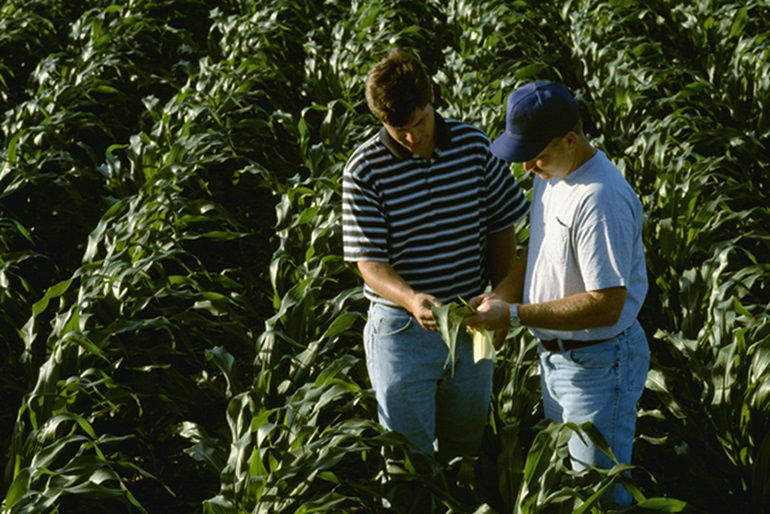Integrated Pest Management for Corn Insects
December 18, 2018

Integrated pest management (IPM) is a comprehensive approach to insect, weed and disease management to protect against yield loss. IPM provides many benefits for farmers, society and the environment. IPM practices offer farmers flexibility, good use of resources, opportunities to increase yields and profits, new technology and reduced potential for weed resistance.
IPM for insects includes planting corn hybrids with traits that confer resistance to insects and other pests, using seed treatments, scouting and identifying insect pests, making timely insecticide applications when needed, and using cultural practices to diminish the threat from insects.
Hybrid selection
Effective and economical insect control in corn production relies heavily on selecting the appropriate Bt corn hybrid. After growers consider a hybrid’s high yield potential, area adaptation and disease package, they can use different Bt technologies for insect control and resistance management. Growers can also use hybrids with multiple Bt traits for the same pest to assist with resistance management.
Seed treatments
Using the correct insecticide seed treatment and rate is another way to provide effective and economical insect control in corn production. Seed treatments protect corn seed and young corn plants from insects, nematodes, disease and other threats to plant health and yield.
Scouting
After corn emerges, consistent scouting, which includes sampling and insect identification, is the best way to know what pests are in the field and whether or not they will threaten yields and profits. Different corn pests appear at different times. A calendar from Purdue University pinpoints when most corn pests are likely to occur and gives specific scouting information for each type of pest. Problem infestation areas may be related to soil conditions. If only one side of a field shows insect problems, it may be related to an invasion from a field border. Keep in mind that in corn fields, problem areas with sharply defined edges could be a sign of insect damage, or they may be the result of nematode or herbicide injury.
For general scouting, start at a different point each week. Pick a random pattern in advance and walk without consciously choosing good or bad areas. Sample after regular intervals – every 20 steps or so. Walk to within 30 feet of each field edge, as many problems start from the sides of the field.
Take samples of insects and scan the entire field for possible insect damage while walking from one site to the next. Observe the plants around the sample site while looking for patterns or variations. If insects and damage are not easily identified, consult county Extension personnel or a pest identification guide.
Thresholds and best scouting methods vary by insect pest, corn hybrid, timing of planting and geographic location. Thresholds for pest populations that require insecticide applications also vary, and the determination should be based on timely regional information from sources such as a university Extension service.
Insecticide applications
A soil-applied insecticide can be used at planting to control insects such as corn rootworm larvae, white grubs, cutworms, wireworms and seedcorn maggots. When insect counts indicate that above-ground insect populations have exceeded economic thresholds, growers can consult with sources such as a university Extension service to make timely, judicious foliar applications of insecticides.
Cultural practices
Cultural practices can affect insect pest populations. For example, planting field corn early, during the recommended planting window, will reduce the risk of crop damage from several late-season insect species such as corn borers and fall armyworms. Crop rotation also helps fend off insect populations. Soil sampling every few years to test for insect populations is another helpful practice.
Additionally, predators and parasites can often keep a pest population from reaching treatable levels. Be aware of population levels of naturally occurring predators and parasites and recognize that treatment thresholds can sometimes be increased with high predator populations.
Weed control
Certain insects are carriers of virus diseases in corn. Controlling weeds such as Johnsongrass early in the season reduces the chances that leafhoppers and aphids will transmit viruses to corn. For example, when planting corn in fields known to be heavily infested with Johnsongrass, choose a hybrid with good tolerance to the maize dwarf mosaic virus (MDMV) complex. Additionally, reduce insect breeding areas in host weeds, such as pigweeds or marestail, through herbicide applications.
Tillage
No-till production systems can exacerbate insect pest problems in many cases. Cutworms, wireworms, white grubs, seed corn maggots and lesser cornstalk borers may build up in grass sod or where previous crop residue has been left on the soil surface at planting. A herbicide burndown three to four weeks prior to planting can reduce infestation risks. When soil is disturbed during land preparation, scout for white grubs, wireworms and any other insects that may be exposed.
Bayer Solutions to Help Control Insect Pests in Corn
The best approach to managing insect pests in corn is preventive control.
Baythroid® XL insecticide, a pyrethroid, performs on a broad spectrum of corn insect pests with fast knockdown and long residual control. At-planting application is recommended; however, Baythroid XL may be used throughout the growing season. Application timing should be based on careful scouting and local economic thresholds.
To learn more about insect control options from Bayer and Baythroid XL insecticide, contact your local Bayer representative.
Common corn insect pests
Learn more about common corn insect pests and control recommendations:
*Always read and follow label instructions. Not all products are registered for use in every state. Baythroid XL is a Restricted Use Pesticide.